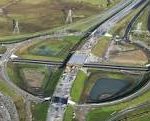A sheer rock face, possibly the height of a three or four storey apartment block, has been hewn out of the earth near Ballinphuil, Corofin by massive machines that look like models to the naked eye from above the new M17-M18 Tuam-Gort motorway as progress continues apace on the project.
Neither this massive rock face nor the thousands of tonnes of peat that have been scooped out of the earth at Galway Road, Tuam have slowed down DirectRoute (Tuam) Limited’s work on the motorway.
Travelling from Tuam to Annagh Hill along the loose gravel and stone surface is now possible when one is taken on the bumpy, bone shaking ride in a jeep by two of the company’s officials, Declan Carney and Cian O’Sullivan, who know the route intimately.
It was a rocky journey, taking almost two hours, which is the sort of time that it will take motorists from here to get to the outskirts of Dubin when the new motorway opens in early 2018.
This northern section of the motorway crosses the Grange and Abbert rivers as well as a number of small roads where underpasses and flyovers will become part of the landscape. DirectRoute have also been putting in underpasses for a number of farmers to ensure that sections of their lands are not separated.
Meanwhile the three Tuam Bypass fly-overs will be visible at Weir Road, Airglooney and Kilcloghans.
Another is nearing completion over the railway line near the former Tuam Sugar Factory.
Work on this will soon be complete, according to Cian O’Sullivan, technical manager for the overall project.
“The beams for the top of this bridge should be put in place by a giant crane over two days early in August,” says Cian.
He added that space for an additional rail track has been left beside the existing disused railway line in case it is ever put back in use.
The Tuam Bypass and the section of the motorway south as far as Annagh Hill is being constructed by Roadbridge while Sisk take over from there going south. There are four civil engineering firms involved in the DirectRoute consortium, the others being Lagan and Strabag, Declan Carney, General Manager for the project, says they all work well together.
“We have already worked together on the Limerick tunnel and the N8 Fermoy Bypass,” he says.
“At present we have over 500 working on the overall route with 330 of those employed from this region.”
“We also have 339 pieces of machinery on the project and, similar to a large section of the workforce, much of the materials have also been sourced locally,” said Declan.
This is evidenced by the amount of Corripipe made by JFC in Tuam that is being used, alongside some larger concrete pipes for drainage purposes.
His colleague Cian added that advance planning, including archaeological surveys, is vital to ensure progress of such projects.
“In Ireland it must be the most extensively archaeologically surveyed project of its type in advance to it starting,” said Cian.
He added that environmentally they are taking extreme care too, with silt traps, along the sides of rivers and streams.
“This is to make sure that no suspended solids or any other contaminants get into local waterways.”
Declan added that the blasting of rock and the removal of peat is being done in a very careful manner.
There is no rock blasting before mid-morning and a special boom microphone device monitors the noise levels. Another device, similar to a goblet for measuring rainfall, is placed strategically along the route at intervals to measure dust levels.
“Removing the peat near the Tuam end is not as challenging as it is for the engineering team to work on replacing it with the solid new road surface that is emerging there,” he concluded.



